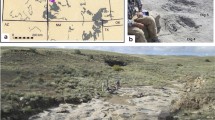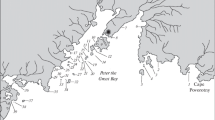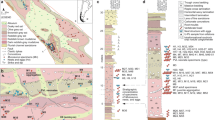Abstract
Recent discoveries in the late Cretaceous (Campanian) Two Medicine Formation of western Montana indicate that some dinosaur species, like some modern species of birds and crocodiles, nested in colonies. I report here evidence that members of one species returned to the same nesting area for many years. There are also indications that, after hatching, some species remained in their respective nests whereas others left the nest but remained in, or at least returned occasionally to, the nesting site. The area in which these discoveries were made is the Willow Creek Anticline of Teton County, where in 1978 a nest of fifteen, 1-m long hadrosaurs provided the first evidence of extended parental care among dinosaurs1.
Similar content being viewed by others
References
Horner, J. R. & Makela, R. Nature 282, 296–298 (1979).
Lorenz, J. C. thesis, Princeton Univ. (1981).
Coombs, W. P. Nature 283, 380–381 (1980).
Hunt, R. C. Copeia 1975, 763–764 (1975).
Pooley, A. C. Animal Kingdom 79, 7–13 (1976).
Pooley, A. C. & Gans, C. Scient. Am. 234, 114–124 (1976).
Welty, J. C. The Life of Birds, 546 (Knopf, New York, 1963).
Author information
Authors and Affiliations
Rights and permissions
About this article
Cite this article
Horner, J. Evidence of colonial nesting and ‘site fidelity’ among ornithischian dinosaurs. Nature 297, 675–676 (1982). https://doi.org/10.1038/297675a0
Received:
Accepted:
Issue Date:
DOI: https://doi.org/10.1038/297675a0
- Springer Nature Limited
This article is cited by
-
Ancient Mongolian nests show that dinosaurs protected their eggs
Nature (2019)
-
High-latitude neonate and perinate ornithopods from the mid-Cretaceous of southeastern Australia
Scientific Reports (2019)
-
Huge haul of rare pterosaur eggs excites palaeontologists
Nature (2017)
-
Vitakridrinda (Vitakrisauridae, Theropoda) from the latest Cretaceous of Pakistan
Journal of Earth Science (2010)
-
Nest and egg clutches of the dinosaur Troodon formosus and the evolution of avian reproductive traits
Nature (1997)





